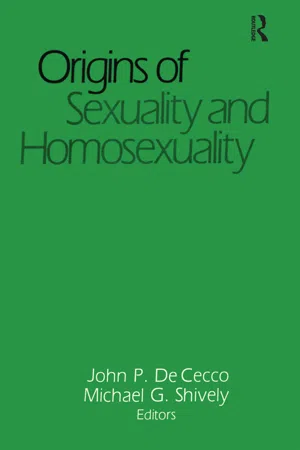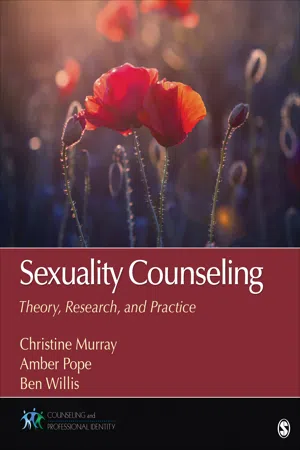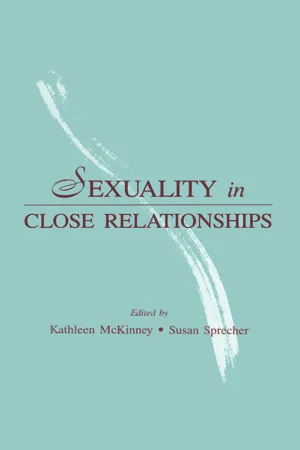Psychology
Sexual Relationships
Sexual relationships refer to the intimate connections and interactions between individuals that involve sexual activity, attraction, and emotional bonding. These relationships can encompass a wide range of dynamics, including physical, emotional, and psychological elements, and are influenced by cultural, social, and personal factors. Understanding sexual relationships is important in exploring human behavior, emotions, and interpersonal dynamics.
Written by Perlego with AI-assistance
Related key terms
4 Key excerpts on "Sexual Relationships"
- eBook - ePub
- John Dececco, Phd, Michael Shively(Authors)
- 2014(Publication Date)
- Routledge(Publisher)
ABSTRACT. The article has three major purposes. First, it adumbrates four contexts within which the discourse on sexual identity has been carried on: the historical, bisexual, homosexual, and biological. Within these contexts sexual identity has been conceived in three general forms: the biological, psychological, and socio-cultural. The biological form is the most basic since all conceptualizations of sexual identity make the biological sex of partners in Sexual Relationships the criterial distinction. Second, the article addresses problems that have arisen in each of the contexts: the uncritical use of popular concepts and explanations of sexual identity, the incorporation of unacknowledged moral judgements, and the misapplication of the scientific method. Third, it identifies conceptual, methodological, and moral advantages in redirecting the discourse on sexual identity so that the focus of inquiry is on Sexual Relationships: (a) The focus is shifted from isolated individuals to their mutual associations. (b) Social scientists could conceive of Sexual Relationships in other than biological terms or metaphors. (c) The shift would capitalize on the advantages of the psychoanalytic method (the exploration of personally constructed meanings) and symbolic interactionism (the identification of socially constructed meanings) while avoiding the pitfalls of relying on one of these approaches to the exclusion of the other. (d) The shift would allow investigators to view Sexual Relationships from the vantage point of a morality of individual choice rather than a traditional morality of externally imposed obligation.The idea of sexual identity has many diverse meanings which derive from the scientific discourse within which it developed. The discourse occurred chiefly in European and American psychiatry, medicine, and the social sciences from the middle of the nineteenth century to the present.The purpose of this article is, first, to adumbrate four contexts within which that discourse has occurred: the historical, bisexual, homosexual, and biological. The second purpose is to address research problems that have arisen in each context: the uncritical use of popular concepts and explanations of sexual identity, the incorporation of unacknowledged moral judgements, and the misapplication of the scientific method. Third, the article identifies possible conceptual advantages in redirecting the discourse on sexual identity so that the focus of inquiry is on Sexual Relationships. Finally, it shows how the articles in this monograph contribute to the understanding of Sexual Relationships.The key concepts in this analysis are sexual identity and Sexual Relationships. In the various contexts, sexual identity is conceived as an essence, interiorly lodged within the individual, one which determines whether the individual has only female or only male sexual partners or both females and males. If the partners are of the opposite biological sex, the individual’s identity is called heterosexual. If partners are of the same biological sex, the identity is designated as homosexual. If partners are of both sexes, it is bisexual.A sexual relationship can be defined by its structure, the constituent elements of which are the attitudes of partners that inform their treatment of each other. These attitudes may, for example, include beliefs about biological sex, femininity and masculinity, complementarity, exclusivity, sensuosity, intimacy, and permanency. The structure of a sexual relationship consists of the implications or consequences of partners’ having various attitudes. For example, partners may view a relationship as a network of externally prescribed obligations or they may view it as consisting of both negotiated and personal choices. These differing views of relationships would probably have sharply contrasting structural implications or consequences. As such, the structure is unknown to the partners because it is the conceptualization of the social scientist who notes the implications of partners’ holding similar or dissimilar sets of beliefs. As noted by F. A. Hayek (1952 - eBook - ePub
Sexuality Counseling
Theory, Research, and Practice
- Christine E. (Elizabeth) Murray, Amber L. Pope, Benjamin T. (Tinsley) Willis(Authors)
- 2016(Publication Date)
- SAGE Publications, Inc(Publisher)
Chapter 8 Sexuality and Intimate RelationshipsThe intimacy in sex is never only physical. In a sexual relationship we may discover who we are in ways otherwise unavailable to us, and at the same time, we allow our partner to see and know that individual. As we unveil our bodies, we also disclose our persons.—Thomas Moore, 1940The dynamics of intimate relationships play a significant role in the types and frequency of sexual activities and in the connection that people experience as sexual beings. Romantic attraction, intimacy, attachment styles, sexual desire, and relational patterns are some of the relationship dynamics that impact relational and sexual satisfaction. Integrating sexuality counseling with couples counseling can be beneficial for clients, and counselors should be prepared to address both sexual and relational aspects that relate to clients’ presenting concerns. There are also specific relationship situations (i.e., infidelity, divorce, and dating) that counselors should understand and be prepared to work with clients in the context of intimate relationships. This chapter will address relational dynamics of sexuality, the integration of couples and sexuality counseling, and some specific relationship situations that may arise in sexuality counseling. After reading this chapter, readers will be able to do the following:- Discuss dynamics of intimate relationships that impact sexuality
- Understand the impact of attachment on relationship and sexual processes in couples
- Describe the advantages of integrating sexuality counseling with couples counseling
- Identify strategies to use to address specific relationship concerns in counseling
The Dynamics of Couple Relationships
Intimate relationships are not just the sum of their parts; what goes on inside each individual, as well as the relationship itself, creates many different patterns and dynamics that can be confusing and overwhelming when beginning to work with couples. Counseling couples is different than counseling individual clients because of the change of focus from one individual to two people’s relationship with each other. Sexual concerns almost always are of importance in couples counseling, and there are several relevant layers that are important to conceptualize and address when working with couples with regard to sexuality. Ideally, partners will hold similar values and beliefs with one another in terms of important sexuality-related topics, although that is not always the case. Intimacy is about being close with another person and sharing oneself with that person. There are many ways that people can share themselves with others, involving varying degrees of engagement, attraction, closeness, and desire. One important sexual dynamic in couples’ relationships is romantic attraction. - eBook - ePub
Odyssey of the Heart
Close Relationships in the 21st Century
- John H. Harvey(Author)
- 2001(Publication Date)
- Routledge(Publisher)
4SEXUALITY IN CLOSE RELATIONSHIPS
Sex is a wave that just sweeps over me. When the urge comes, I am helpless.—Michael Douglas in describing his many romances, Parade Magazine (August 29, 1999, p. 2)Sex is hardly ever just about sex.—Shirley MacLaine (The Quotable Woman, 1991, p. 119)In this chapter, the varied meanings of sexuality in close relationships is discussed. Far from being simply a biological process, sexuality emerges from the circumstances and meanings available to people. As we will see in each chapter, gender difference questions are at the forefront of a large stream of contemporary work on sexuality in close relationships.An illustrative recent study was conducted by Regan and colleagues (2000). They assessed college students’ partner preferences for short-term sexual and long-term romantic partners. For a sample of 561 respondents, it was found that for either short-term sexual liaisons or long-term romance, men emphasized attributes related to sexual desirability more than did women, and women valued characteristics related to social status more than did men. For short-term sexual interactions, both men and women emphasized qualities such as attractiveness, health, sex drive, and athleticism. On the other hand, both women and men emphasized personality qualities such as intelligence, honesty, and warmth in their long-term romantic partners. The gender differences in this study partially support an evolutionary psychology position on dating and mating, which stresses men’s emphasis on health and attractiveness and women’s emphasis on resources and social status for sexual contacts, romance, and mating.The vastness of meanings of sexuality was suggested by Sanders and Reinisch (1999) who reported on a sample of 600 college undergraduates concerning their notions of what sex is. Fifty-nine percent did not consider oral–genital contact to be “having sex.” Nineteen percent believed that penile–anal contact was not “having sex.” And these are just the physical relations. How varied might the answers be if psychological aspects of sexuality were included in such a survey? - eBook - ePub
- Kathleen McKinney, Susan Sprecher(Authors)
- 2014(Publication Date)
- Psychology Press(Publisher)
In addition, cross-sex friends must offer to the larger social network an accounting for the nontraditional mode of their relationship. Male/female friendship pairs are subject to outside attributions of hidden sexual agendas, lack of awareness of their own sexual attraction, or even inferences that one or both partners are homosexual (O'Meara, 1989). If the couple is unable to neutralize or ignore these attributions, the friendship may eventually become a more conventional romantic relationship, diminish in its importance, or terminate.Sexual Episodes in Developing Romantic Relationships
Although sexual attraction may be more easily assimilated into a romantic relationship than a friendship, managing sexual involvement is still a communicative challenge. Sexual episodes are microcosms of the broader interpersonal relationship in which they occur. They represent encounters in which partners negotiate the time, place, manner, and meaning of sexual interaction. In the next section, we specifically consider the moves that relational partners make to initiate, resist, and direct sexual activity.Initiation of Sexual Activity
At early stages of intimacy, the negotiation of sexual activity can be a particularly difficult accomplishment. Individuals attempt to meet multiple goals related to the situation, including impression management and relationship definition. These attempts are complicated by the fact that partners may possess different sexual experiences and standards. Partners also frequently differ in their sexual vocabularies (e.g., Sanders, 1978; Sanders & Robinson, 1979; Simkins & Rinck, 1982; Wells, 1989). Moreover, partners lack breadth and depth of information about each other.In the absence of detailed and intimate knowledge about each other, partners rely on generalized cultural scripts for guidance regarding how relationships ought to progress, and what actions would be appropriate to escalate and restrain relationship development (Baxter, 1987). "Scripts are hypothesized cognitive and performative structures which organize a person's comprehension of situated events and guide a person's performance of a situated set of actions" (Ginsburg, 1988, p. 29). Initiation of sexual activity in heteroSexual Relationships is consistent with the sociobiological theory that men seek to propagate widely, whereas women seek to propagate wisely (Hinde, 1984). The traditional stereotype holds that men perform the role of sexual initiation and that women control the occurrence of sexual activity (LaPlante, McCormick, & Brannigan, 1980; McCormick, 1979; Peplau, Rubin, & Hill, 1977).
Index pages curate the most relevant extracts from our library of academic textbooks. They’ve been created using an in-house natural language model (NLM), each adding context and meaning to key research topics.



